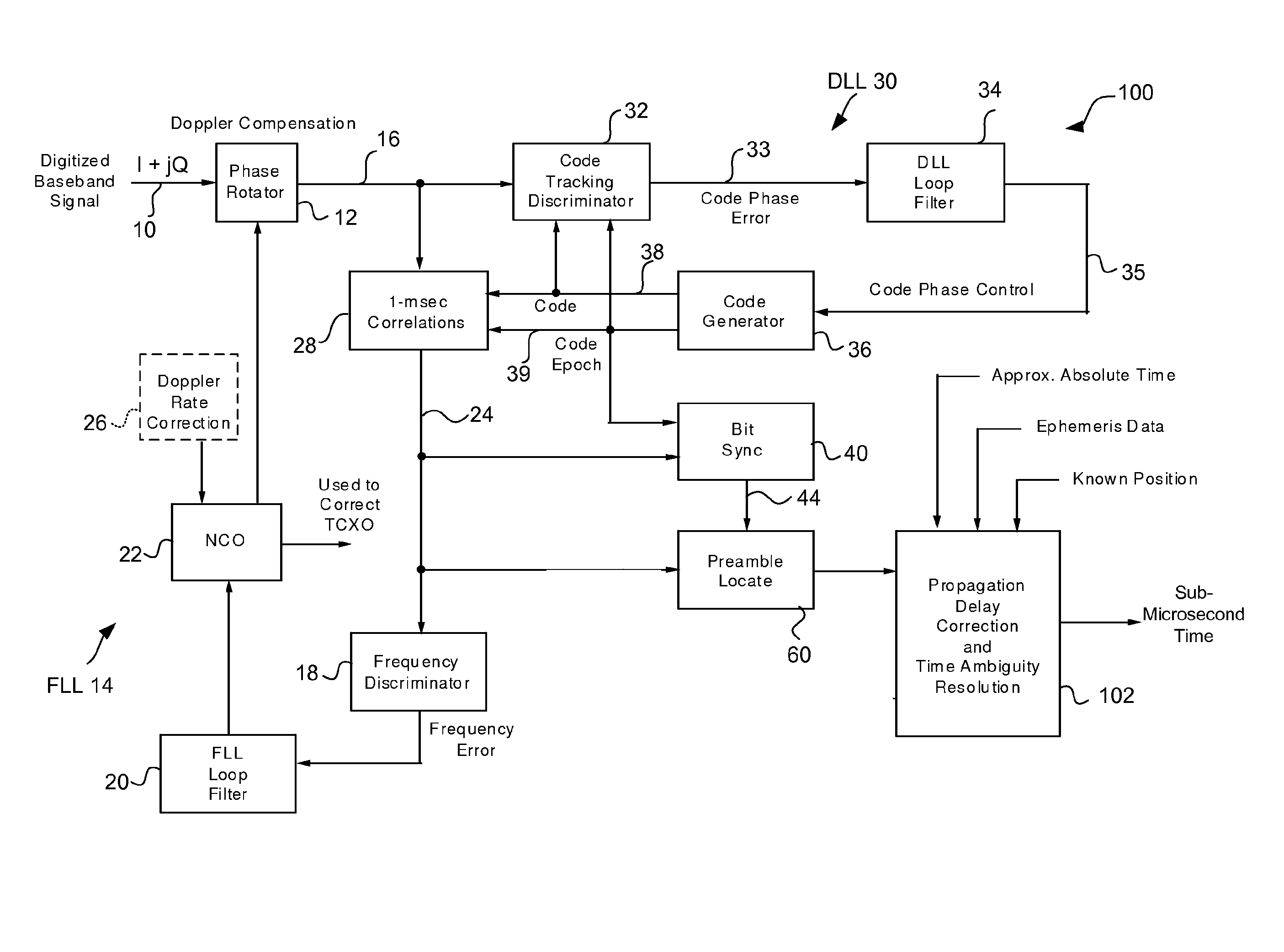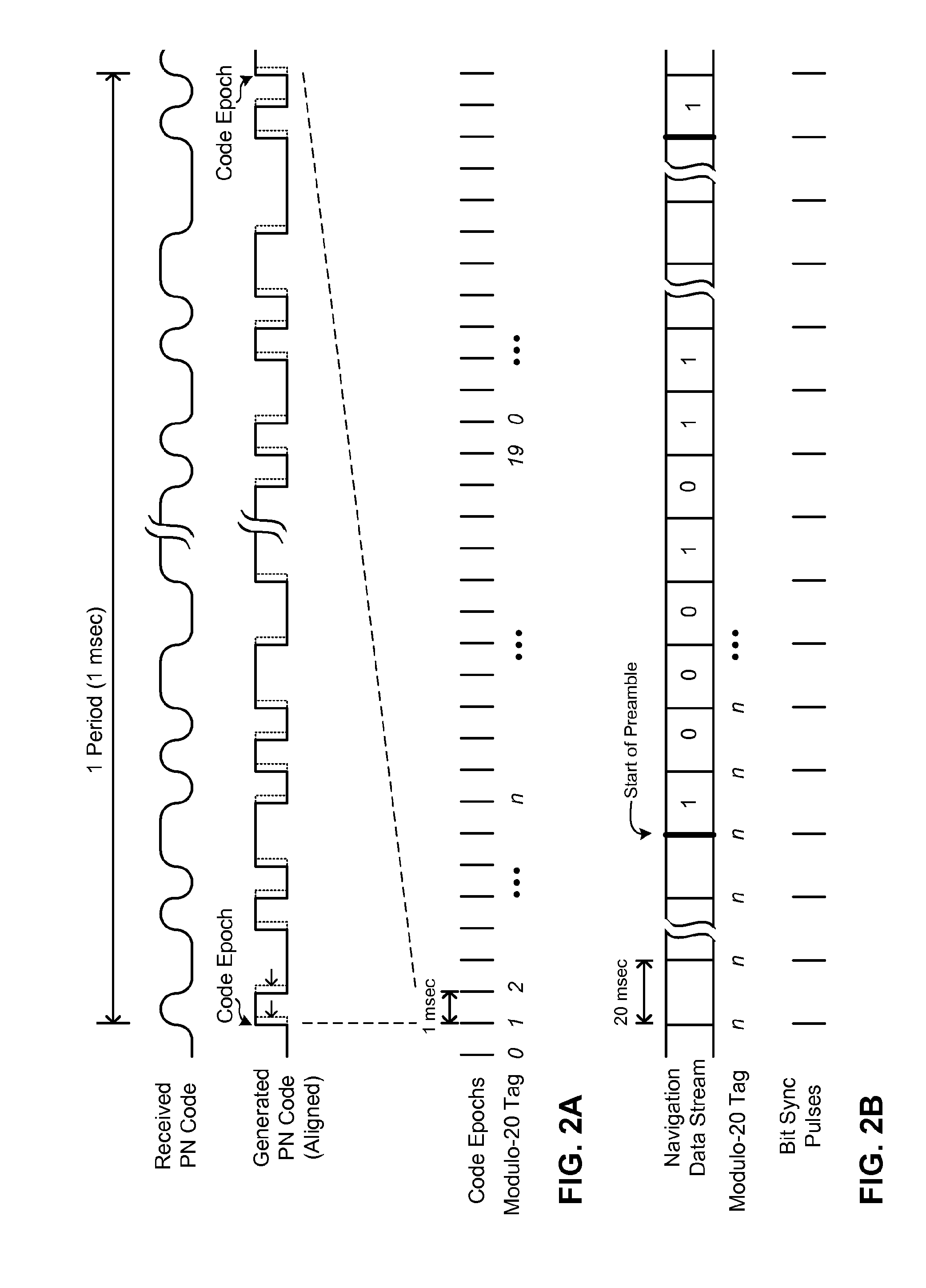Method and apparatus for acquisition, tracking, and sub-microsecond time transfer using weak gps/gnss signals
- Summary
- Abstract
- Description
- Claims
- Application Information
AI Technical Summary
Benefits of technology
Problems solved by technology
Method used
Image
Examples
embodiment 1
Accurate Tracking of Previously-Acquired Satellite and Sub-Microsecond Time Transfer
[0084]FIG. 1 is a block diagram schematically illustrating a method and corresponding circuitry 100 for accurate tracking of a previously-acquired satellite and sub-microsecond time transfer using a known receiver position, in accordance with one embodiment of the present invention. If more satellite signals are available, all elements in the figure are replicated for each satellite tracked. FIG. 1 only shows part of a GPS receiver which is able to track a satellite and obtain very accurate time, i.e., sub-microsecond time from a very weak GPS signal. It is assumed that the position of the receiver is known within approximately 100 meters for sub-microsecond accuracy, and that a satellite signal has already been acquired and code and carrier frequency tracking have been initiated. That is, as shown in FIG. 1, the input signal to the circuitry 100 is a digitized baseband signal 10 which is received by...
example 1
Detecting Occurrence of the Subframe Preamble
[0099]FIG. 4 schematically illustrates the frame and subframe structure of the GPS navigation data stream. A complete navigation data message consists of 25 frames, each containing 1500 bits transmitted at a 50 bit / sec rate. Each frame is subdivided into five 300-bit subframes (#1 through #5 in FIG. 4), each subframe consisting of 10 words of 30-bits each, with the most significant bit (MSB) transmitted first. Thus, at the 50 bits / sec rate, it takes 6 seconds to transmit a subframe, and 30 seconds to complete one frame. Transmission of the complete 25-frame navigation message requires 750 seconds, or 12.5 minutes. Except for occasional updating, subframes #1, #2, and #3 are mostly constant (i.e., repeat) with each frame at the 30 second frame repetition rate. On the other hand, subframes #4 and #5 are each subcommutated 25 times. The 25 versions of subframes #4 and #5 are referred to as pages 1-25. Hence, except for occasional updating, e...
example 2
Detecting the Occurrence of a Larger Segments of Bits
[0112]FIG. 7 schematically illustrates an alternative way of obtaining signal transmission time, in accordance with another embodiment of the present invention, which detects the occurrence of larger segments of data bits in the navigation message. In FIG. 7, the like elements bear the like reference numerals as those in FIG. 1. As shown in FIG. 7, the circuitry 120 includes a target segment locator 80 in place of the preamble locator 60 in FIG. 1. Since it is assumed that satellite ephemeris data, satellite clock correction data, almanac data, and perhaps other data, such as Time of Week (TOW), in the navigation message is available from an external source, this information can be used to determine the bit sequences that are used to transmit it. Since the position of these known bit sequences relative to the start of a frame is known, the occurrence of the first bit at the start of a frame can also be determined from the detected...
PUM
 Login to View More
Login to View More Abstract
Description
Claims
Application Information
 Login to View More
Login to View More - R&D
- Intellectual Property
- Life Sciences
- Materials
- Tech Scout
- Unparalleled Data Quality
- Higher Quality Content
- 60% Fewer Hallucinations
Browse by: Latest US Patents, China's latest patents, Technical Efficacy Thesaurus, Application Domain, Technology Topic, Popular Technical Reports.
© 2025 PatSnap. All rights reserved.Legal|Privacy policy|Modern Slavery Act Transparency Statement|Sitemap|About US| Contact US: help@patsnap.com



